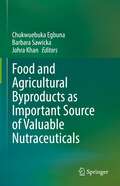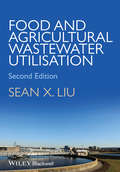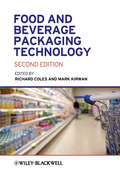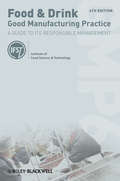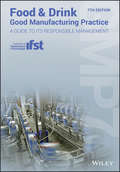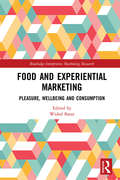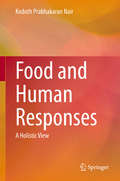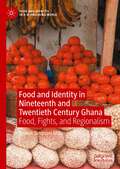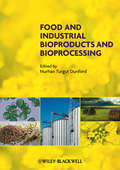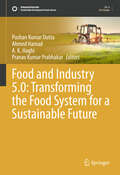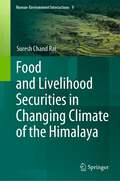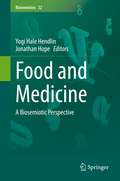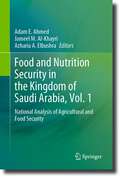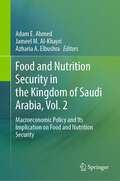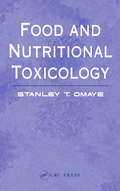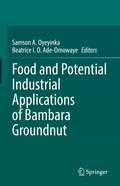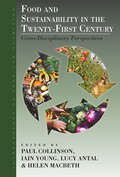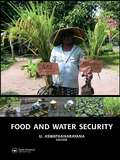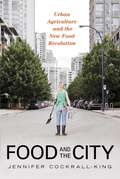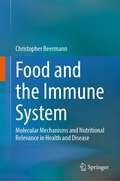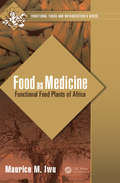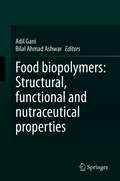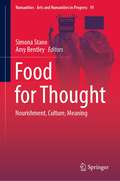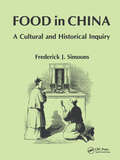- Table View
- List View
Food and Agricultural Byproducts as Important Source of Valuable Nutraceuticals
by Chukwuebuka Egbuna Barbara Sawicka Johra KhanFood and agricultural by-products are leftovers or wastes from parts of foods, fruits, vegetables and animal sources which are obtained after processing. Agricultural by-products includes peels and rinds from citrus fruits, pineapple, mango, and banana. Other notable ones are pomace from apple, olive, red beet, and those from wine making. Also, whey from milk, straws, hulls, and brans from grains are among top agricultural by-products. These by-products often impact the environment and the social-economic sectors when they are disposed. But with the recent advances in biotechnology and scientific research, scientists have found usefulness in some of these byproducts as sources of valuable nutraceuticals, a term used to refer to chemical entities present in foods that has the propensity to impact health for disease prevention and treatment. This book entitled ‘Food and agricultural by-products as important source of valuable nutraceuticals’ presents detailed information about major agricultural byproducts that are rich in nutraceuticals. The nature and the type of nutraceuticals that they contains and their health promoting benefits were presented. The editors and chapter contributors are renowned experts from key institutions around the globe. This book will be useful to students, teachers, food chemists, nutritionists, nutritional biochemists, food biotechnologists among others. Key features Ø Highlights the health promotion benefits of nutraceuticals Ø Presents information on agrifood by-products as sources of nutraceuticals Ø Discusses functional nutraceuticals from peels, rinds, pomace, hull, bran etc
Food and Agricultural Wastewater Utilization and Treatment
by Sean X. LiuWastes, whether they are solid wastes or wastewater, are resources from which economic values may be derived. Almost all components of agricultural and food wastewater can be and should be utilized or recovered; the stumbling block of achieving this aspiration is economical, not technical. The last one and a half decades have seen the surging of agricultural and non-agricultural commodity prices across the board and increased public consciousness of environmental impact of industrial wastewater discharge and treatment. The confluence of these new developments have generated new interests and applications of agricultural and food wastewater and their treatment residuals in diverse fields and industries. This new edition will expand topics related to wastewater utilizations and new uses of treatment residuals while providing up-to-date information on new treatment technologies and practices across the globe. The new edition’s target audience is anyone who has the responsibility of dealing with its plant effluents in agricultural and food processing operations. It should be of value to waste management personnel responsible for managing major waste effluents from agro and food industries. It will also be useful for college students whose majors are in environmental science or waste management fields as a reference.
Food and Beverage Packaging Technology
by Mark J. Kirwan Richard ColesNow in a fully revised and updated second edition, this volume provides a contemporary overview of food processing/packaging technologies. It acquaints the reader with food preservation processes, shelf life and logistical considerations, as well as packaging materials, machines and processes necessary for a wide range of packaging presentations. The new edition addresses environmental and sustainability concerns, and also examines applications of emerging technologies such as RFID and nanotechnology. It is directed at packaging technologists, those involved in the design and development of packaging, users of packaging in food companies and those who specify or purchase packaging. Key Features: An up-to-date and comprehensive handbook on the most important sector of packaging technology Links methods of food preservation to the packaging requirements of the common types of food and the available food packages Covers all the key packaging materials - glass, plastics and paperboard Fully revised second edition now covers sustainability, nanotechnology and RFID
Food and Drink - Good Manufacturing Practice: A Guide to its Responsible Management
by Institute of Food Science and Technology Louise ManningGood Manufacturing Practice (GMP) refers to advice and guidance put in place to outline the aspects of production and testing that can impact the quality and safety of a product. In the case of food and drink, GMP is aimed at ensuring that products are safe for the consumer and are consistently manufactured to a quality appropriate to their intended use. Manufacturers have for several years been driving towards such goals as Total Quality Management (TQM), lean manufacturing and sustainability – GMP is bound up with these issues. The ever-increasing interest amongst consumers, retailers and enforcement authorities in the conditions and practices in food manufacture and distribution, increases the need for the food manufacturer to operate within clearly defined policies such as those laid down in GMP. The ability to demonstrate that Good Manufacturing Practice has been fully and effectively implemented could, in the event of a consumer complaint or a legal action, reduce the manufacturer’s liability and protect them from prosecution. First launched in 1986, IFST’s Good Manufacturing Practice Guide has been widely recognized as an indispensable reference work for food scientists and technologists. It sets out to ensure that food manufacturing processes deliver products that are uniform in quality, free from defects and contamination, and as safe as it is humanly possible to make them. This 6th edition has been completely revised and updated to include all the latest standards and guidance, especially with regard to legislation-driven areas such as HACCP. The Guide is a must have for anyone in a managerial or technical capacity concerned with the manufacture, storage and distribution of food and drink. It is also a valuable reference for food education, training and for those involved in food safety and enforcement. Food scientists in academic and industry environments will value its precision, and policy makers and regulatory organizations will find it an indispensable guide to an important and multifaceted area. About IFST IFST is the leading independent qualifying body for food professionals in Europe and the only professional body in the UK concerned with all aspects of food science and technology. IFST members are drawn from all over the world and from all ages and backgrounds, including industry (manufacturing, retailing and food service), universities and schools, government, research and development, quality assurance and food law enforcement. IFST qualifications are internationally recognised as a sign of proficiency and integrity.
Food and Drink - Good Manufacturing Practice: A Guide to its Responsible Management (GMP7)
by Institute of Food Science and Technology Louise ManningThe latest updated edition of the market-leading guide to Good Manufacturing Practice (GMP) in the food and drink industry This all-new, 7th edition of Food and Drink - Good Manufacturing Practice: A Guide to its Responsible Management features a wealth of new information reflecting changes in the industry and advances in science that have occurred since the publication of the last edition back in 2013. They include topics such as: Food Safety Culture, Food Crime and Food Integrity Management Systems, Food Crime Risk Assessment including vulnerability risk assessment and Threat Analysis Critical Control Point (TACCP), Security and Countermeasures, Food Toxins, Allergens and Risk Assessment, Provenance and authenticity, Electronic and digital traceability technologies, Worker Welfare Standards; Smart Packaging, Food Donation Controls and Animal Food Supply, Safety Culture; Provenance and integrity testing and Sustainability Issues. In addition to the new topics mentioned above, Food and Drink - Good Manufacturing Practice, 7th Edition offers comprehensive coverage of information in chapters on Quality Management System; Hazard Analysis Critical Control Point (HACCP); Premises and Equipment; Cleaning and Sanitation; Product Control, Testing and Inspection; Heat Preserved Foods; Frozen Foods; Foods for Catering and Vending Operations; and much more. Comprises both general guidance and food sector-specific requirements for good manufacturing practice Incorporates all the most recent developments and changes in UK and EU law Provides a readable and accessible reference for busy managers in the food industry Food and Drink - Good Manufacturing Practice: A Guide to its Responsible Management, 7th Edition is a valuable reference for anyone in a managerial or technical capacity concerned with the manufacture, storage, and distribution of food and drink. The book is also a “must –read” for the recommended reading lists for food science, food technology and food policy undergraduate and postgraduate studies. IFST - the Institute of Food Science and Technology is the leading qualifying body for food professionals in Europe and the only professional qualifying body in the UK concerned with all aspects of food science and technology.
Food and Experiential Marketing: Pleasure, Wellbeing and Consumption (Routledge Interpretive Marketing Research)
by Wided BatatPleasure plays a significant but often neglected role in the creation of consumer wellbeing and the relationship between the food consumption experience and healthy eating. This innovative collection focusses on the experiential and hedonic aspects of food and the sociocultural, economic, ideological, and symbolic factors that influence how pleasure can contribute to consumer health, food education, and individual and societal wellbeing. Food and Experiential Marketing uses a holistic perspective to explore how the experiential side of food pleasure may drive healthy eating behaviors in varied food cultures. It questions: Is food pleasure an ally or an enemy of developing and adopting healthy eating habits? Can we design healthy offline and online food experiences that are pleasurable? What are the features of food consumption experiences, and how do they contribute to consumer wellbeing? Providing an overview of experiential and cultural issues in food marketing, this book will be invaluable for consumer behavior and food marketing scholars, public policy professionals, and the food industry in understanding the importance of pleasure in promoting healthy eating behaviors.
Food and Human Responses: A Holistic View
by Kodoth Prabhakaran NairThis book discusses the role of food and the human nutrition-behavior interface. Food makes us what we are, but in addition to providing adequate nutrition, does it influence behavior? This book looks at this critical question from various angles and considers different concepts and approaches to food, nutrition and well-being. To better understand the entire gamut of the food-behavior linkage, the author unravels the workings of the mind - brain link. The book discusses this aspect and the findings add to the existing fund of knowledge in this area. Much of today’s malaise in humans can be traced to the food consumed by individuals. This book provides a comprehensive picture of the current state of human nutrition and how this can be linked to behavior.
Food and Identity in Nineteenth and Twentieth Century Ghana: Food, Fights, and Regionalism (Food and Identity in a Globalising World)
by Brandi Simpson MillerThis book investigates how cooking, eating, and identity are connected to the local micro-climates in each of Ghana’s major eco-culinary zones. The work is based on several years of researching Ghanaian culinary history and cuisine, including field work, archival research, and interdisciplinary investigation. The political economy of Ghana is used as an analytical framework with which to investigate the following questions: How are traditional food production structures in Ghana coping with global capitalist production, distribution, and consumption? How do land, climate, and weather structure or provide the foundation for food consumption and how does that affect the separate traditional and capitalist production sectors? Despite the post WWII food fight that launched Ghana’s bid for independence from the British empire, Ghana’s story demonstrates the centrality of local foods and cooking to its national character. The cultural weight of regional traditional foods, their power to satisfy, and the overall collective social emphasis on the ‘proper’ meal, have persisted in Ghana, irrespective of centuries of trade with Europeans. This book will be of interest to scholars in food studies, comparative studies, and African studies, and is sure to capture the interest of students in new ways.
Food and Industrial Bioproducts and Bioprocessing
by Nurhan Turgut DunfordFood and Industrial Bioproducts and Bioprocessing describes the engineering aspects of bioprocessing, including advanced food processing techniques and bioproduct development. The main focus of the book is on food applications, while numerous industrial applications are highlighted as well. The editors and authors, all experts in various bioprocessing fields, cover the latest developments in the industry and provide perspective on new and potential products and processes. Challenges and opportunities facing the bioproduct manufacturing industry are also discussed. Coverage is far-reaching and includes: current and future biomass sources and bioprocesses; oilseed processing and refining; starch and protein processing; non-thermal food processing; fermentation; extraction techniques; enzymatic conversions; nanotechnology; microencapsulation and emulsion techniques; bioproducts from fungi and algae; biopolymers; and biodegradable/edible packaging. Researchers and product developers in food science, agriculture, engineering, bioprocessing and bioproduct development will find Food and Industrial Bioproducts and Bioprocessing an invaluable resource.
Food and Industry 5.0: Transforming the Food System for a Sustainable Future (Sustainable Development Goals Series)
by A. K. Haghi Pranav Kumar Prabhakar Pushan Kumar Dutta Ahmed Hamad"Food and Industry 5.0: Transforming the Food System for a Sustainable Future" offers a groundbreaking exploration of cutting-edge technologies reshaping the global food landscape. This comprehensive volume delves into innovations driving the fifth industrial revolution in food production and distribution. The book examines nanotechnology and biosensor applications in food processing and safety, analyzing their potential to revolutionize quality monitoring, extend shelf life, and enhance traceability. It unveils the transformative power of artificial intelligence and machine learning across the food value chain, from plant disease detection to sustainable poultry production. Significant attention is given to the integration of Internet of Things (IoT) and digital twin technology in agriculture and food supply chains, offering insights into real-time monitoring, predictive maintenance, and optimization techniques. The text explores robotics in food manufacturing, emphasizing advancements in efficiency, waste reduction, and safety. Crucial methodologies for quantifying and analyzing complex agricultural data are addressed, presenting both regression and classification approaches in precision agriculture. Sustainability is a key focus, with chapters examining nano-fertilizers, soil amendments, and AI-integrated crop systems designed to advance UN Sustainable Development Goals. Blockchain technology's role in enhancing food traceability and safety is investigated, complete with real-world case studies. The book addresses the complex regulatory landscape surrounding Industry 5.0 technologies, including waste management in hospitality and ethical considerations of AI deployment. Concluding chapters offer forward-looking analyses of emerging trends in dairy, diet, and hospitality subsectors. This meticulously researched volume employs a wide array of methodologies, from experimental studies to economic modeling and qualitative research. "Food and Industry 5.0" is an indispensable resource for food scientists, agricultural researchers, computer scientists, policymakers, and industry professionals. By bridging multiple disciplines, it provides a scientifically rigorous, data-driven roadmap for creating a more sustainable, efficient, and ethical global food system.
Food and Livelihood Securities in Changing Climate of the Himalaya (Human-Environment Interactions #9)
by Suresh Chand RaiThis book provides viewpoints on a cross-sectoral, multiscale assessment of food and livelihood security in changing climate, the main global threats of the 21st century. Climate change, directly and indirectly, influences several aspects of food security, primarily in the farming and livestock sectors. The farming sector is the main source of income and employment for about 70% of the Himalayan populace. However, there has been no such study that has comprehensively covered these aspects.Additionally, the book offers critical mitigation measures to adapt to climate change and other uncertainties. The agricultural diversities and livelihood security in the Himalayan region will be sustainable only if farmers applied suggested mitigation measures correctly.This title is appropriate for postgraduates and research scholars of social sciences, environmental sciences, and agricultural sciences. Regional planners, government officers, NGOs, and many other people who are interested in the Himalayan region as well as local communities will be also beneficial.
Food and Medicine: A Biosemiotic Perspective (Biosemiotics #22)
by Jonathan Hope Yogi Hale HendlinThis edited volume provides a biosemiotic analysis of the ecological relationship between food and medicine. Drawing on the origins of semiotics in medicine, this collection proposes innovative ways of considering aliments and treatments. Considering the ever-evolving character of our understanding of meaning-making in biology, and considering the keen popular interest in issues relating to food and medicines - fueled by an increasing body of interdisciplinary knowledge - the contributions here provide diverse insights and arguments into the larger ecology of organisms’ engagement with and transformation through taking in matter. Bodies interpret molecules, enzymes, and alkaloids they intentionally and unintentionally come in contact with according to their pre-existing receptors. But their receptors are also changed by the experience. Once the body has identified a particular substance, it responds by initiating semiotic sequences and negotiations that fulfill vital functions for the organism at macro-, meso-, and micro-scales. Human abilities to distill and extract the living world into highly refined foods and medicines, however, have created substances far more potent than their counterparts in our historical evolution. Many of these substances also lack certain accompanying proteins, enzymes, and alkaloids that otherwise aid digestion or protect against side-effects in active extracted chemicals. Human biology has yet to catch up with human inventions such as supernormal foods and medicines that may flood receptors, overwhelming the body’s normal satiation mechanisms. This volume discusses how biosemioticians can come to terms with these networks of meaning, providing a valuable and provocative compendium for semioticians, medical researchers and practitioners, sociologists, cultural theorists, bioethicists and scholars investigating the interdisciplinary questions stemming from food and medicine.
Food and Nutrition Security in the Kingdom of Saudi Arabia, Vol. 1: National Analysis of Agricultural and Food Security
by Jameel M. Al-Khayri Adam E. Ahmed Azharia A. ElbushraFood and nutrition security is a major concern for Saudi Arabia and the surrounding regions due to the range of challenges they face. These challenges include limited agricultural resources, low self-sufficiency in key food staples, climate change, and high levels of food loss and waste. This book aims to evaluate and analyze the current situation and future prospects of food and nutrition security in Saudi Arabia. Additionally, it seeks to analyze and assess the roles and functions of various institutions related to food security, providing a deeper understanding of the complex problems associated with it. Furthermore, this book aligns with Kingdom Vision 2030, which includes a set of strategies and programs focused on agriculture, food, and water security. It also aligns with the institutional identity of King Faisal University's "Food Security and Environmental Sustainability".The book consists of four volumes. Volume 1, entitled "National Analysis of Agriculture and Food Security" aims to assess the current state of food security in Saudi Arabia, covering key aspects such as agriculture and food resources, food systems, crops, livestock, poultry, fisheries, animal health, food loss and waste, transportation and strategic reserve infrastructure, food security institutions, population, agricultural extension, climate change, agricultural mechanization, smart agriculture, and the utilization of solar energy.This book is highly significant for professionals, researchers, policymakers, and entrepreneurs involved in food and nutrition security in Saudi Arabia, the Gulf Cooperation Council, and various national and international organizations. It offers a comprehensive analysis of the obstacles and possibilities in ensuring food and nutrition security, as well as presenting practical approaches to address these issues. Additionally, graduate students studying in fields related to food and nutrition security will benefit from this book.
Food and Nutrition Security in the Kingdom of Saudi Arabia, Vol. 2: Macroeconomic Policy and Its Implication on Food and Nutrition Security
by Jameel M. Al-Khayri Adam E. Ahmed Azharia A. ElbushraFood and nutrition security is a major concern for Saudi Arabia and the surrounding regions due to the range of challenges they face. These challenges include limited agricultural resources, low self-sufficiency in key food staples, climate change, and high levels of food loss and waste. This book aims to evaluate and analyze the current situation and future prospects of food and nutrition security in Saudi Arabia. Additionally, it seeks to analyze and assess the roles and functions of various institutions related to food security, providing a deeper understanding of the complex problems associated with it. Furthermore, this book aligns with Kingdom Vision 2030, which includes a set of strategies and programs focused on agriculture, food, and water security. It also aligns with the institutional identity of King Faisal University's "Food Security and Environmental Sustainability".The book consists of four volumes. Volume 2 is entitled "Macroeconomic Policy Implications on Food and Nutrition Security". It covers various areas, including food price, loss and waste, processing, finance, trade, investment, quality and safety, consumption patterns, climate change, early warning systems, nutrition institutions, oil revenue, and the significance of date palm and Hassawi rice, genetically modified food, and edible insects in ensuring food and nutritional security.This book is highly significant for professionals, researchers, policymakers, and entrepreneurs involved in food and nutrition security in Saudi Arabia, the Gulf Cooperation Council, and various national and international organizations. It offers a comprehensive analysis of the obstacles and possibilities in ensuring food and nutrition security, as well as presenting practical approaches to address these issues. Additionally, graduate students studying in fields related to food and nutrition security will benefit from this book.
Food and Nutritional Toxicology
by Stanley T. OmayeFood and Nutritional Toxicology provides a broad overview of the chemicals in food that have the potential to produce adverse health effects. The book covers the impact on human health of food containing environmental contaminants or natural toxicants, food additives, the migration of chemicals from packaging materials into foods, and the persisten
Food and Potential Industrial Applications of Bambara Groundnut
by Samson A. Oyeyinka Beatrice I. O. Ade-OmowayeBambara groundnut (Vigna subterranea) is a crop native to the Bambara tribe of Mali and is grown as a subsistence crop in Africa. Recent advances in research, however, have brought the crop to the forefront of the sustainable agriculture movement.The Bambara plant is highly drought tolerant and rich in protein and carbohydrates, including starch. These macromolecules have enormous industrial potentials. For example, the starch in Bambara grain has been found to exhibit higher (double) viscosity than conventional corn starch. Modified Bambara groundnut starch has been used to produce edible bioplastics that could be upgraded industrially to suit the fourth industrial revolution shift.Bambara plants are also a natural source of soluble fiber, which is gluten-, lactose- and cholesterol-free, with potential as a stabiliser, thickener and gelling agent as well as a cryoprotectant in frozen products. The health benefits include lowering of cholesterol levels, levelling of blood glucose and as a detoxing aid. Furthermore, several researchers have explored the grain either alone or as composite with cereal and tubers for the development of value-added products.Food and Potential Industrial Applications of Bambara Groundnut presents in a clear, coherent way the research findings on Bambara grain and its status as a promising food and industrial crop.
Food and Sustainability in the Twenty-First Century: Cross-Disciplinary Perspectives (Anthropology of Food & Nutrition #9)
by Helen Macbeth Paul Collinson Iain Young Lucy AntalSustainability is one of the great problems facing food production today. Using cross-disciplinary perspectives from international scholars working in social, cultural and biological anthropology, ecology and environmental biology, this volume brings many new perspectives to the problems we face. Its cross-disciplinary framework of chapters with local, regional and continental perspectives provides a global outlook on sustainability issues. These case studies will appeal to those working in public sector agencies, NGOs, consultancies and other bodies focused on food security, human nutrition and environmental sustainability.
Food and Water Security
by U. AswathanarayanaThis book deals with ways and means of managing food and water security in various agroclimatic environments through the integration of R & D, training, people participation, agronomic practices, economic instruments, and administrative policies. It includes contributions by global experts in the field, who elaborate on the governance of f
Food and the City
by Jennifer Cockrall-KingA global movement to take back our food is growing. The future of farming is in our hands--and in our cities.When you're standing in the midst of a supermarket, it's hard to imagine that you're looking at a failing industrial food system. The abundance all around you looks impressive but is really a façade. In fact, there's just a three-day supply of food available for any given city due to complex, just-in-time international supply chains. The system is not only vulnerable, given the reality of food scares, international crises, terrorist attacks, economic upheavals, and natural disasters, but it is also environmentally unsustainable for the long term. As the cold hard facts of peak oil and peak water begin to have an impact, how will we feed a world population of seven billion and growing, most of whom are now urban dwellers? One answer is urban agriculture. This book examines alternative food systems in cities around the globe that are shortening their food chains, growing food within their city limits, and taking their "food security" into their own hands. This award-winning food journalist sought out leaders in the urban-agriculture movement and visited cities successfully dealing with "food deserts." What she found was not just a niche concern of activists but a global movement that cuts across the private and public spheres, economic classes, and cultures. She describes a global movement happening from London and Paris to Vancouver and New York to establish alternatives to the monolithic globally integrated supermarket model. A cadre of forward-looking, innovative people has created growing spaces in cities: on rooftops, backyards, vacant lots, along roadways, and even in "vertical farms." Whether it's a community public orchard supplying the needs of local residents or an urban farm that has reclaimed a derelict inner city lot to grow and sell premium market veggies to restaurant chefs, the urban food revolution is clearly underway and working.This book is an exciting, fascinating chronicle of a game-changing movement, a rebellion against the industrial food behemoth, and a reclaiming of communities to grow, distribute, and eat locally.
Food and the Immune System: Molecular Mechanisms and Nutritional Relevance in Health and Disease
by Christopher BeermannNutrition is an important environmental factor for the maturation of the human immune system and essential for maintaining immunological homeostasis. Based on this, a variety of food applications with medical claims are being generated by food manufacturers worldwide in order to expand the market potential of products creating interesting linkages with other market segments, such as cosmetics and pharmaceuticals. However, in addition to the health benefits, active principles of such components often remain unexplored.This book focusses on the specific interactions between food ingredients and the immune system along the entire immune defense response. Starting from the immune barrier, through the innate and adaptive immune response, to active limitation and termination, all major mechanisms of the immune response are addressed and different biochemical, cellular and genetic interactions of components of our diet are discussed. The book presents a wealth of disease patterns for which nutritional factors are relevant and thereby provides indications for potential intervention strategies. In addition, associated food-technological aspects are discussed. Being the first of its kind, this book provides an overview of the variety of functional food components and their influence on immunological responses. Written in an accessible style, it addresses researchers, health professionals and students with different scientific backgrounds.
Food as Medicine: Functional Food Plants of Africa (Functional Foods and Nutraceuticals)
by Maurice M. IwuThis comprehensive book documents African plants used for functional and medicinal foods. It contains more than 60 detailed monographs of African foods, describing foods with various characteristics such as prebiotic, probiotic, satiety, immune modulation, stress-reduction, sports performance, mental acuity, sleep-supporting, metabolic syndrome, antioxidant, and unsaturated fats. Plant description, botanical names and synonyms, plant part used, habitat and distribution, folk use, nutritional content, and chemistry are all fully detailed. The book highlights indigenous African food processing technologies up to the modern era.
Food biopolymers: Structural, functional and nutraceutical properties
by Adil Gani Bilal Ahmad AshwarFood biopolymers: Structural, functional and nutraceutical properties provides valuable coverage of all major food biopolymers from plant, animal and marine sources. The text focuses on the structural characteristics of biopolymers including starch, non-starch polysaccharides, proteins and fats. A full section is dedicated to the nutraceutical potential and applications of these polymers. Further sections provide comprehensive overviews of the development of functional food products and important data on biopolymer behavior and nutraceutical potential during processing. Researchers hoping to gain a basic understanding of the techno-functional, nutraceutical potential and applications of food biopolymers will find a singular source with this text. The first section of this work focuses on the the structure, functions, bioactivity and applications of starches. The next chapters cover non-starch polysaccharides. Further sections are dedicated to proteins, lipids and oils. A detailed overview is provided for each, followed by application procedures, specifics on individual types, proteins and enzymes, and nutraceutical properties. This work can be used as a singular source for all relevant information on food biopolymers and their structural and functional properties, including their potential to increase food quality, improve shelf life, and reduce pollution and waste in the food industry.
Food for Thought: Nourishment, Culture, Meaning (Numanities - Arts and Humanities in Progress #19)
by Amy Bentley Simona StanoThis volume offers new insights into food and culture. Food habits, preferences, and taboos are partially regulated by ecological and material factors - in other words, all food systems are structured and given particular functioning mechanisms by specific societies and cultures, either according to totemic, sacrificial, hygienic-rationalist, aesthetic, or other symbolic logics. This provides much “food for thought”. The famous expression has never been so appropriate: not only do cultures develop unique practices for the production, treatment and consumption of food, but such practices inevitably end up affecting food-related aspects and spheres that are generally perceived as objectively and materially defined. This book explores such dynamics drawing on various theoretical approaches and analytical methodologies, thus enhancing the cultural reflection on food and, at the same time, helping us see how the study of food itself can help us understand better what we call “culture”. It will be of interest to anthropologists, philosophers, semioticians and historians of food.
Food in China: A Cultural and Historical Inquiry
by Frederick J. SimoonsThis volume is a study of Chinese food from a cultural and historical perspective. Its focus is on traditional China before establishment of the People's Republic. It identifies and provides comprehensive information on a broad range of Chinese food plants and animals for general readers, as well as for specialists whose interests have led them to
Food in a Just World: Compassionate Eating in a Time of Climate Change
by Tracey Harris Terry GibbsFood in a Just World examines the violence, social breakdown, and environmental consequences of our global system of food production, distribution, and consumption, where each step of the process is built on some form of exploitation. While highlighting the broken system’s continuities from European colonialism, the authors argue that the seeds of resilience, resistance, and inclusive cultural resurgence are already being reflected in the day-to-day actions of communities around the world. Calling for urgent change, the book looks at how genuine democracy would give individuals and communities meaningful control over the decisions that impact their lives when seeking to secure humanely this most basic human need. Drawing on the perspectives of advocates, activists, workers, researchers, and policymakers, Harris and Gibbs explore the politics of food in the context of capitalist globalization and the climate crisis, uncovering the complexities in our relationships with one another, with other animals, and with the natural world.
